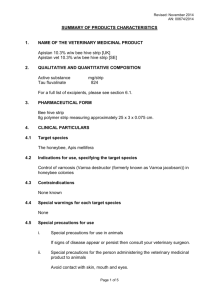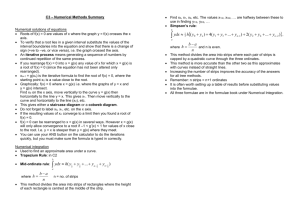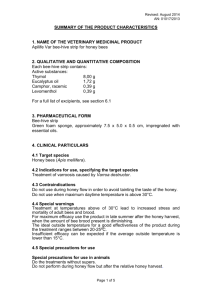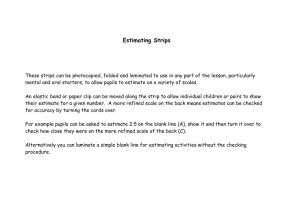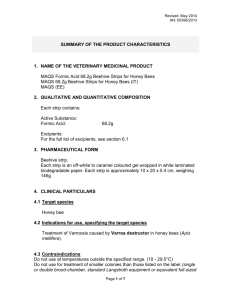Revised: December 2011 AN. 01933/2010 SUMMARY OF
advertisement
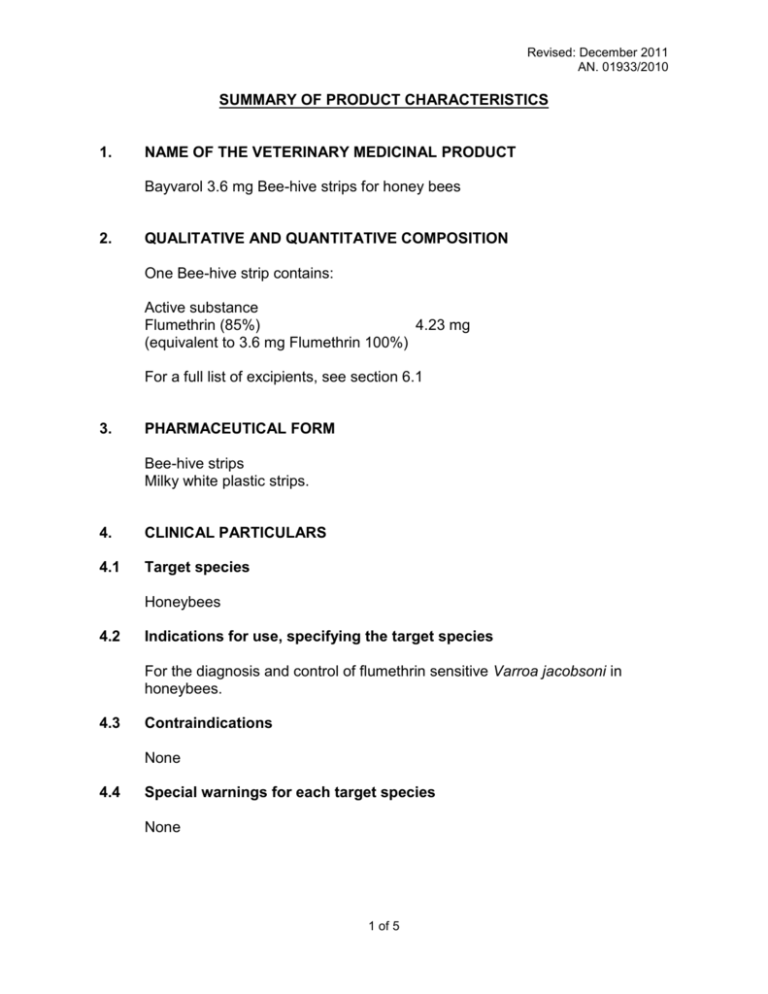
Revised: December 2011 AN. 01933/2010 SUMMARY OF PRODUCT CHARACTERISTICS 1. NAME OF THE VETERINARY MEDICINAL PRODUCT Bayvarol 3.6 mg Bee-hive strips for honey bees 2. QUALITATIVE AND QUANTITATIVE COMPOSITION One Bee-hive strip contains: Active substance Flumethrin (85%) 4.23 mg (equivalent to 3.6 mg Flumethrin 100%) For a full list of excipients, see section 6.1 3. PHARMACEUTICAL FORM Bee-hive strips Milky white plastic strips. 4. CLINICAL PARTICULARS 4.1 Target species Honeybees 4.2 Indications for use, specifying the target species For the diagnosis and control of flumethrin sensitive Varroa jacobsoni in honeybees. 4.3 Contraindications None 4.4 Special warnings for each target species None 1 of 5 Revised: December 2011 AN. 01933/2010 4.5 Special precautions for use i) Special precautions for use in animals None ii) Special precautions to be taken by the person administering the veterinary medicinal product to animals Wash hands after handling the strips, before meals and after work. When using do not eat drink or smoke. Do not open foil bags until immediately prior to use. Avoid the strips coming into contact with honey to be harvested for human consumption. iii) Other precautions None 4.6 Adverse reactions (frequency and seriousness) There were no adverse effects in those colonies treated with Bayvarol strips and those with a placebo control. 4.7 Use during pregnancy, lactation or lay Not applicable 4.8 Interaction with other medicinal products and other forms of interaction None known. 4.9 Amount(s) to be administered and administration route Bayvarol strips are intended for in-hive use. Bayvarol Strips are suspended into the spaces between the combs in the central brood-rearing area in such a way that they can be occupied by bees on both sides. Both tabs are bent upwards in the same direction at the marked fold lines and hooked over the top edge of the wooden frame. For large colonies occupying several brood chambers, two strips can be joined together end-to-end which enables their insertion into and removal from the beespaces without having to separate the brood chambers. Normally developed colonies receive four strips. 2 of 5 Revised: December 2011 AN. 01933/2010 Nuclei and young colonies and newly collected swarms receive half that dose i.e. two strips Large colonies occupying several brood chambers receive four strips per chamber which are distributed over the central beespaces in each brood chamber. Time and Duration of Use Best efficacy is to be expected when Bayvarol is used in late summer after the honey harvest. Ideally the strips should not be used during the peak honey flow periods. However, Bayvarol can be used at any time of the year for diagnosis or in severe infestations where there is a threat to the survival of the colony. Diagnosis The strips are inserted into the colony for 24 hours. Before inserting the strips the floor tray is covered with a clean sheet of paper. This is then checked for the presence of dead Varroa mites 24 hours later. Treatment The strips should be left in the colonies for a maximum of six weeks and then removed. 4.10 Overdose (symptoms, emergency procedures, antidotes), if necessary Studies in which double the normal number of strips were used during the winter period showed no adverse effects on the bees or any adverse effect on subsequent breeding. 4.11 Withdrawal period(s) No withdrawal period for honey is required regardless of when in the year Bayvarol is used. Other bee produce should not be taken for human consumption until the spring following treatment. 5. PHARMACOLOGICAL PROPERTIES Pharmacotherapeutic group: Ectoparasiticides for topical use, incl. insecticides ATCVet Code: QP53AC05 Flumethrin is a synthetic pyrethroid compound acting by pre- and postsynaptic induction of repetitive action potentials and perturbation of axonal impulses by changes in K+ / Na+ permeability. 3 of 5 Revised: December 2011 AN. 01933/2010 5.1 Pharmacodynamic properties Flumethrin is a type II synthetic pyrethroid and causes a long-lasting prolongation of the normally transient increase in sodium permeability of the nerve membrane during excitation, resulting in long-lasting trains of repetitive firing. The α-cyano group on the phenoxy-fluorobenzyl alcohol moiety is considered to be responsible for the long-lasting prolongation of sodium permeability. The type II pyrethroids produce a distinct poisoning syndrome which is characterised by choreoathetosis (sinuous writhing of the whole body) and salivation. 5.2 Pharmacokinetic particulars ABSORPTION: Percutaneous absorption in mammals is minimal. 6. PHARMACEUTICAL PARTICULARS 6.1 List of excipients Low density polyethylene 6.2 Incompatibilities None known 6.3 Shelf-life Shelf-life of the veterinary medicinal product as packaged for sale: 5 years Shelf-life after first opening the immediate packaging: 6 weeks 6.4 Special precautions for storage Do not store above 25ºC. Store away from food, drink and animal feedingstuffs. 6.5 Nature and composition of immediate packaging Aluminium/Polyester/PE foil bag containing 4 bee-hive strips Pack size(s): 5 bags per carton and 200 bags per carton. Not all pack sizes may be marketed. 4 of 5 Revised: December 2011 AN. 01933/2010 6.6 Special precautions for the disposal of unused veterinary medicinal product or waste materials derived from the use of such products Bayvarol should not enter water courses as this may be dangerous for fish and other aquatic organism. Therefore do not contaminate ponds, waterways and ditches with the strip or used packaging. Any unused veterinary medicinal product or waste materials derived from such veterinary medicinal products should be disposed of in accordance with local requirements. 7. 8. 9. 10. MARKETING AUTHORISATION HOLDER UK: IE: Bayer plc, Animal Health Division, Bayer House, Strawberry Hill, Newbury, Berkshire RG14 1JA Bayer Ltd, Animal Health Division, The Atrium, Blackthorn Road, Dublin 18, Ireland MARKETING AUTHORISATION NUMBERS UK Only: IE Only Vm 00010/4090 VPA 10021/50/1 DATE OF FIRST AUTHORISATION UK Only: IE Only 17 July 1992 28 July 1992 DATE OF REVISION OF THE TEXT December 2011 PROHIBITION OF SALE, SUPPLY AND/OR USE Not applicable 5 of 5
